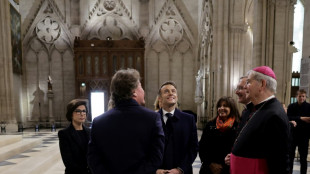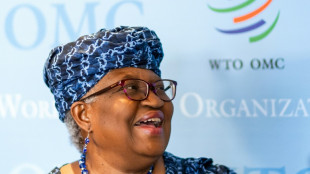
-
 Amorim puts faith in Mount to turn around Man Utd career
Amorim puts faith in Mount to turn around Man Utd career
-
Guardiola will not 'run' from Man City rebuild

-
 Assisted dying campaigners, opponents rally at UK parliament
Assisted dying campaigners, opponents rally at UK parliament
-
Durable prop Healy set to carve name in Irish rugby history

-
 Macron unveils Notre Dame after 'impossible' restoration
Macron unveils Notre Dame after 'impossible' restoration
-
Traumatised Spain marks one month since catastrophic floods

-
 Yen rallies, euro up on rising inflation data
Yen rallies, euro up on rising inflation data
-
Attack-minded Spurs boss Postecoglou says: 'You'll miss me when I'm gone'

-
 Syria jihadists, allies shell major city Aleppo in shock offensive
Syria jihadists, allies shell major city Aleppo in shock offensive
-
Macron inspects 'sublime' Notre Dame after reconstruction

-
 Arsenal must be near-perfect to catch Liverpool, says Arteta
Arsenal must be near-perfect to catch Liverpool, says Arteta
-
Arrests, intimidation stoke fear in Pakistan's politics

-
 Showdown looms on plastic treaty days before deadline
Showdown looms on plastic treaty days before deadline
-
Ngozi Okonjo-Iweala: the WTO's trailblazing motivator

-
 WTO chief reappointed as Trump threat looms
WTO chief reappointed as Trump threat looms
-
US landmine offer to Ukraine throws treaty into 'crisis': campaign group

-
 British MPs debate contentious assisted dying law
British MPs debate contentious assisted dying law
-
Macron offers first glimpse of post-fire Notre Dame

-
 Syria jihadists, allies shell Aleppo in shock offensive
Syria jihadists, allies shell Aleppo in shock offensive
-
Japan government approves $92 bn extra budget

-
 Toll in Syria jihadist-army fighting rises to 242: monitor
Toll in Syria jihadist-army fighting rises to 242: monitor
-
UK transport secretary quits in setback for Starmer

-
 Days before deadline, plastic treaty draft highlights disagreement
Days before deadline, plastic treaty draft highlights disagreement
-
Crypto boss eats banana art he bought for $6.2 million

-
 Teen news boss criticises Australian social media ban
Teen news boss criticises Australian social media ban
-
Taiwan detects 41 Chinese military aircraft, ships ahead of Lai US stopover

-
 Spain urged to 'build differently' after deadly floods
Spain urged to 'build differently' after deadly floods
-
WTO chief faces heavy task as Trump threat looms

-
 Herbert takes control at Australian Open as Smith tanks
Herbert takes control at Australian Open as Smith tanks
-
Israel PM again warns Iran after top diplomat talks of revising nuclear doctrine

-
 Brilliant Brook's 132 puts England on top against sloppy New Zealand
Brilliant Brook's 132 puts England on top against sloppy New Zealand
-
Brilliant Brook's 132 puts England on top against New Zealand

-
 US landmine offer to Ukraine throws global treaty into 'crisis': campaign group
US landmine offer to Ukraine throws global treaty into 'crisis': campaign group
-
Singapore hangs 4th person in three weeks

-
 Five things to know about NewJeans' shock split from agency
Five things to know about NewJeans' shock split from agency
-
Waste pickers battle for recognition at plastic treaty talks

-
 Ireland votes in closely fought general election
Ireland votes in closely fought general election
-
Top UN court to open unprecedented climate hearings

-
 European countries that allow assisted dying
European countries that allow assisted dying
-
British MPs to debate contentious assisted dying law

-
 Schmidt not expecting hero's welcome on Ireland return
Schmidt not expecting hero's welcome on Ireland return
-
PSG stuck between domestic dominance and Champions League woes

-
 'Hot fight' as unbeaten Bayern visit Dortmund fortress
'Hot fight' as unbeaten Bayern visit Dortmund fortress
-
Bordeaux-Begles' Samu 'not finished yet' with Wallabies

-
 Brook and Pope half-centuries haul England to 174-4 against NZ
Brook and Pope half-centuries haul England to 174-4 against NZ
-
Yen rallies on rate hike bets as equity markets swing

-
 Ukraine superstar Mahuchikh brings 'good vibes' to her war-torn country
Ukraine superstar Mahuchikh brings 'good vibes' to her war-torn country
-
PlayStation at 30: How Sony's grey box conquered gaming

-
 Saudi Arabia hosts UN talks on drought, desertification
Saudi Arabia hosts UN talks on drought, desertification
-
PlayStation: Fun facts to know as Sony's console turns 30


Westminster Abbey: a millennium entwined with royalty
Westminster Abbey, the setting for Queen Elizabeth II's funeral, has been paramount for Britain's royal family for nearly a millennium.
In the 1040s, King Edward the Confessor built a stone church on the site of a Benedictine monastery founded around 960, in a major enlargement.
Construction began on the imposing Gothic abbey of today under the orders of King Henry III in 1245.
It was designed as a place for the coronation and burial of monarchs.
- Coronations -
William I was the first king crowned in the abbey in 1066 -- a tradition which has endured throughout the centuries.
In 1953, Elizabeth II was crowned on the Coronation Chair, as her eldest son Charles will be.
The chair was made in 1300-1301. It enclosed the Stone of Scone, which was used for centuries to crown the kings of Scotland.
The stone was temporarily stolen in an audacious raid by Scottish students in 1950, who accidentally broke it in two.
In 1996, with nationalist sentiment rising, it was symbolically returned to Scotland but will come back from Edinburgh Castle to Westminster for coronations.
The abbey has hosted 38 coronation ceremonies for reigning monarchs.
- Weddings -
The church has also been the scene of royal weddings -- most of them since World War I. The first was when King Henry I married princess Matilda of Scotland on November 11, 1100.
Queen Elizabeth's parents, prince Albert -- later King George VI -- and Elizabeth Bowes-Lyon, wed in the church in 1923.
And Queen Elizabeth married Philip Mountbatten in the abbey in 1947, bringing some royal colour to the post-World War II recovery years.
Queen Elizabeth's sister, Princess Margaret, and her children Princess Anne and Prince Andrew all got married in the abbey.
The last royal wedding was that of Charles's eldest son Prince William, who wed his university sweetheart Kate Middleton in 2011.
Only 14 years earlier in 1997, William attended his mother Diana's funeral in the abbey following her death in a Paris car crash.
- Famous burials -
The abbey is the final resting place of 30 kings and queens, starting with Edward the Confessor. King George II was the last, in 1760.
Around 3,330 people are buried at the abbey, including some of the great figures of British history.
They include Charles Dickens, Geoffrey Chaucer, Samuel Johnson, Rudyard Kipling, Alfred Tennyson, Henry Purcell, William Wilberforce, Laurence Olivier, Thomas Hardy and eight prime ministers.
The ashes of astrophysics giant Stephen Hawking were interred in 2018 between the graves of Isaac Newton and Charles Darwin.
Other notable personalities have memorials in the abbey, including Jane Austen, Benjamin Britten, Noel Coward, Francis Drake, Edward Elgar, Martin Luther King Jr and Oscar Wilde.
There is a memorial stone to wartime prime minister Winston Churchill inside the west entrance.
It sits near the Tomb of the Unknown Warrior, whose body was brought from continental Europe after World War I. The grave represents all Britain's fallen troops.
Queen Elizabeth and her mother before her left their wedding bouquets on the tomb.
- Royal peculiar -
The abbey -- or to give it its full name, the Collegiate Church of St Peter, Westminster -- is a "royal peculiar" which means it is exempt from any ecclesiastical jurisdiction other than that of the monarch.
The British sovereign is the supreme governor of the Church of England.
The abbey can regularly seat around 2,200 people, though most will not be able to see Queen Elizabeth's funeral service due to the screen separating the nave from the choir.
The royal family will sit closest to the coffin.
Around 8,250 squeezed in for Queen Elizabeth's coronation, in specially erected tiers.
The central London church played a major role in Queen Elizabeth's life: besides her wedding, it staged her mother's funeral and celebrations of major landmarks in her record-breaking reign.
At services in the church, Queen Elizabeth and Prince Philip nearly always sat in specially made birch chairs presented by the Canada Club in memory of Canadians who fell in World War II.
The monarch has left her mark on the abbey.
Queen Elizabeth's record reign is celebrated in a stained-glass window unveiled in September 2018. Designed by David Hockney, it represents the Yorkshire countryside in the spring.
The sovereign opened The Queen's Diamond Jubilee Galleries in June 2018. About 16 metres (52 feet) above the abbey floor, they display treasures and tell the story of the church's history.
The abbey is still a working church and holds regular services open to the public.
K.Thomson--BTB
